North Texas Wild: Behaviorist provides emotional enrichment for animals at Boyd sanctuary
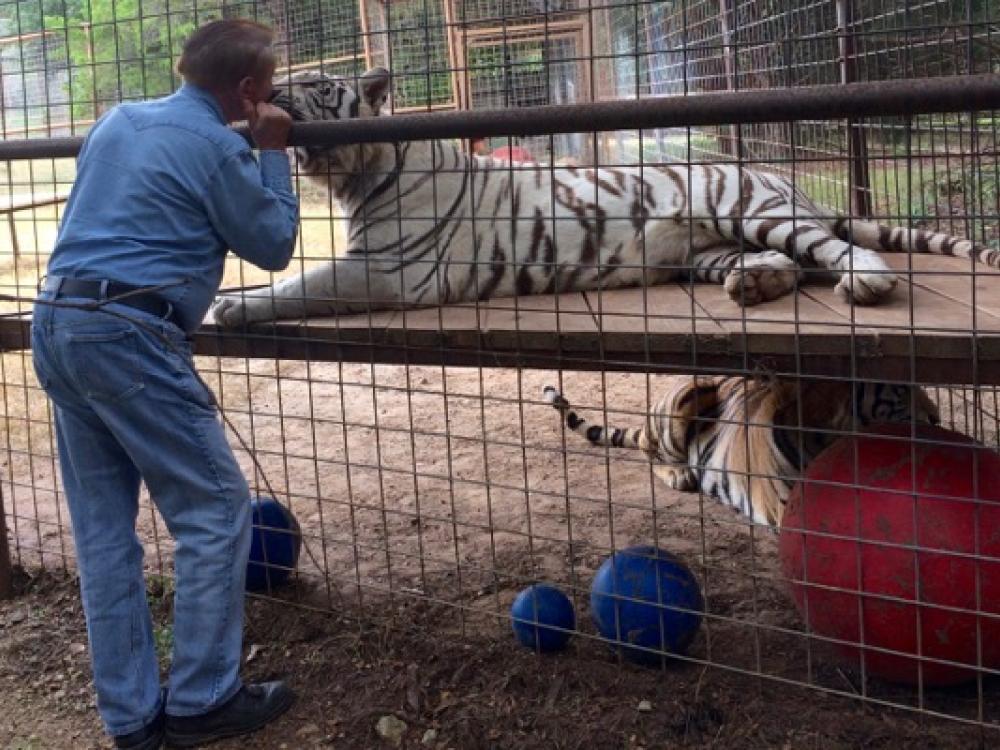
Louis Dorfman greets Louis, a Bengal tiger at International Exotic Animal Sanctuary in Wise County. Photos by Scooter Smith.
by Amy Martin
Oct. 17, 2016
 It’s early afternoon, on the first day of fall that actually felt like fall at the International Exotic Animal Sanctuary, located near Boyd, 35 miles northwest of Fort Worth. The shaded hilly expanse of IEAS is home to 33 lions, tigers, cheetahs, jaguars and pumas/cougars, plus smaller cats like servals, ocelots and bobcats. There are 30 bears of varying species, plus wolves, capybara, ring-tail lemurs and white-nose coati.
It’s early afternoon, on the first day of fall that actually felt like fall at the International Exotic Animal Sanctuary, located near Boyd, 35 miles northwest of Fort Worth. The shaded hilly expanse of IEAS is home to 33 lions, tigers, cheetahs, jaguars and pumas/cougars, plus smaller cats like servals, ocelots and bobcats. There are 30 bears of varying species, plus wolves, capybara, ring-tail lemurs and white-nose coati.
The Bengal tigers Kiki and Kahn hear Louis Dorfman drive up in his golf cart. Round tiger ears pop up from the tall grass in the 7,500-square-foot fenced enclosure, followed by alert turning heads. Their body language seems to say “Yay, it’s Louis!”
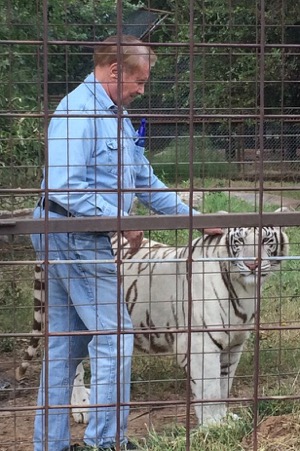 The photographer and I wait in the golf cart parked outside the tall, super-strong chain link fence. A metal pipe bumper around it keeps anyone from approaching too closely. Dorfman, IEAS Chairman of the Board and resident animal behaviorist, enters by himself through an the enclosed double entry. His only protection is a spray bottle of vinegar in his breast pocket.
The photographer and I wait in the golf cart parked outside the tall, super-strong chain link fence. A metal pipe bumper around it keeps anyone from approaching too closely. Dorfman, IEAS Chairman of the Board and resident animal behaviorist, enters by himself through an the enclosed double entry. His only protection is a spray bottle of vinegar in his breast pocket.
Dorfman brings no treats, only relationship, and that’s fine with the cats. They’re in it for the head scratches and nose touches. Kiki and Kahn rub his legs and roll over to show belly. They trust him, are in relationship with him. Louis returns the affection, while never forgetting they are completely and thoroughly wild animals. Though lacking any body language of fear, he rarely turns his back to them or strays far from the fence.
Dorfman visits with the Bengal tiger Kahn.
“I do what’s called emotional enrichment, which is unique to us as a planned program. If you don’t have emotional stability, you don’t have a quality of life. It’s just as important to them as it is to us,” says Dorfman. “I make a point to be very pure about it. I never give any food rewards, so if they choose to have a relationship with me, it’s strictly an emotional one.“
While employees at big cat sanctuaries often become emotionally bonded to their charges, Dorfman’s primary role at IEAS is to provide emotional enrichment and evaluate its effectiveness. For this program, IEAS earned a Certificate of Merit for Zookeeper Education (CMZE) from the American Association of Zoo Keepers. Interns come from across the country to work at IEAS, especially with Dorfman in emotional enrichment.
But, he says, “I’ve worked with over 100 tigers and 50 lions and had over 25,000 individual unprotected contacts with large cats alone. I can only teach at best half of what I know. The other half you must instinctually have a sense of picking up things in the cats and the right way to conduct yourself. It has to be something you have within yourself.”
More captive tigers in Texas than wild in the world
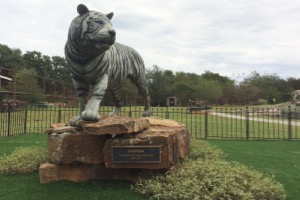 Back in the golf cart, we pass by the busy nutrition center for animal meals and encounter a life-size bronze statue of Sabrina. The white Bengal died of cancer at age 18 after living most of her life at IEAS. Much loved by Dorfman, she is buried underneath the statue. Describing her as an extremely emotional tiger, he shares a few memories of their years of astounding closeness, experiences that surely shaped the sanctuary’s emotional enrichment program. It’s a fine line to let wild animals be animals but still have an emotional connection.
Back in the golf cart, we pass by the busy nutrition center for animal meals and encounter a life-size bronze statue of Sabrina. The white Bengal died of cancer at age 18 after living most of her life at IEAS. Much loved by Dorfman, she is buried underneath the statue. Describing her as an extremely emotional tiger, he shares a few memories of their years of astounding closeness, experiences that surely shaped the sanctuary’s emotional enrichment program. It’s a fine line to let wild animals be animals but still have an emotional connection.
Final resting place of a beloved Bengal tiger, Sabrina, at IEAS.
We approach the enclosure of Nahla, an orange Bengal tiger found at five months of age wandering the streets of Conroe (near Houston) after a flood. Since most municipalities consider ownership of a big cat to be a crime, few are claimed and they end up in animal control agencies that struggle to place them. Favored as a status pet by wealthy business people, especially mafiosos and cartel leaders, big cats also end up homeless after being confiscated by FBI and drug enforcement agents.
Young big cats found in urban areas might have been someone’s exotic pet or used for paid photo opportunities with very young lions and tigers. After becoming too old to be managed easily, these animals often end up in wildlife ranches. Lacking most of their wild instincts, they are killed in canned hunts. Texas is a primary location for both businesses. There are more captive tigers in Texas than there are wild tigers in the world. This forces sanctuaries like IEAS to walk the delicate line between saving these animals and enabling deplorable human behavior.
 “We get animals from confiscations, rescues, abandonment, abuse. The abused animals are mostly adult. Confiscated animals are usually younger, primarily being used for commercial purposes illegally. Then we get ones that were abandoned, and that’s at any age. Or their facility went out of business or had financial troubles.”
“We get animals from confiscations, rescues, abandonment, abuse. The abused animals are mostly adult. Confiscated animals are usually younger, primarily being used for commercial purposes illegally. Then we get ones that were abandoned, and that’s at any age. Or their facility went out of business or had financial troubles.”
Louis Dorfman carries a bottle of vinegar in his pocket as a gentle training aid, which he says he rarely needs.
Now nearly one year old, Nahla spies Dorfman approaching and rubs the fence with vigor, then sits and waits for him to enter the enclosure with its fountain and flowing stream. She’s a feisty thing, wants so much to wrestle, and tugs at his pants legs with teeth. He responds with a strong “No!” and taps the vinegar bottle in his breast pocket until she calms down. She finally notices us in the golf cart and comes over for a close look. She climbs on platforms and shows us how she can walk narrow pieces of lumber and low brick walls, lowers her head and appears to stalk us a bit. We are clearly not on her friends list.
Back in the golf cart, Dorfman remarks, “I use no discipline besides saying no. For the younger ones, this [patting the vinegar bottle] is because they have to learn what is acceptable and what is not. But in over 20 years I’ve only gone through a gallon or so. “
The emotional life of wild animals
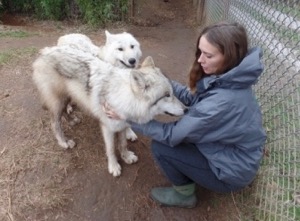 With IEAS’ 50 acres, animals enjoy exceptionally large habitats. Tiger habitats are a minimum of 4,500 square feet per cat and many have flowing water features. Cougar, leopard and jaguar habitats include ramps, platforms and other aids for climbing and jumping. Cheetahs receive grassy hills where they can survey their domain. Most animals have cave-like dens and many get private areas where thy can avoid prying eyes. All have misting systems or other aids for the summer heat.
With IEAS’ 50 acres, animals enjoy exceptionally large habitats. Tiger habitats are a minimum of 4,500 square feet per cat and many have flowing water features. Cougar, leopard and jaguar habitats include ramps, platforms and other aids for climbing and jumping. Cheetahs receive grassy hills where they can survey their domain. Most animals have cave-like dens and many get private areas where thy can avoid prying eyes. All have misting systems or other aids for the summer heat.
Romulus and Remus get some TLC time. Courtesy of IEAS.
More attentive wildness arises as we pass by the enclosure of two grey wolves, Romulus (male) and Remus (female), who came to IEAS as five-month-old siblings. The sanctuary website indicated “their previous institutions no longer had space for them.”
“Unlike their reputation, wolves can be very loveable and sweet,” says Dorfman, “but these two are skittish. I still need more emotional enrichment time with them.”
Romulus keeps his distance from Dorfman and his eyes on us in the golf cart, but Dorfman enthralls Remus. There’s a coquettishness to her body language, and she’s frisky from the cooler weather. Remus nips on Dorfman’s long sleeves and he responds by saying “No!” loudly a few times. She steps backs and rolls around in the dirt in response, showing bits of belly.
“I feel you should treat them as you would treat a human,” says Dorfman, “in a sense that you should give them the same respect and dignity, concern for their welfare. The idea is for keepers to develop a mutually respectful relationship with the animals. We provide companionship that the animals might otherwise miss in a captive setting.”
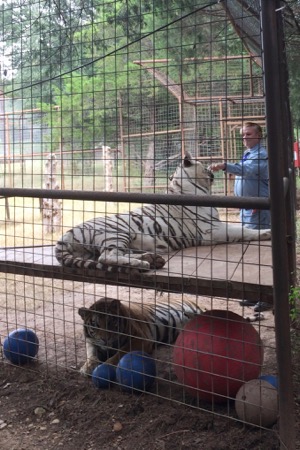 We drive a short distance to a shaded enclosure where a giant white Bengal tiger named Louis lounges on an elevated platform against the fence. As tigers go, Louis is very chill. Ignoring us in the golf cart, he looks over as the human Louis enters the enclosure and emits a languid “hey” of a chuff, a sound happy tigers make that is between a snort and a small roar. His tail is quiet and body language submissive.
We drive a short distance to a shaded enclosure where a giant white Bengal tiger named Louis lounges on an elevated platform against the fence. As tigers go, Louis is very chill. Ignoring us in the golf cart, he looks over as the human Louis enters the enclosure and emits a languid “hey” of a chuff, a sound happy tigers make that is between a snort and a small roar. His tail is quiet and body language submissive.
The “very instinctual” Julia stares intently at the writer and photographer from beneath the platform where her brother Louis rests.
Looking around for Louis’ yellow Bengal tiger sister, Julia, we gasp a bit to see along the fence. We are the total object of her focus and she growls a bit when the photographer raises the camera. Every muscle on her face says predator. While laid-back Louis would be unable to make it in the wild, says the human Louis, “Julia is very instinctual.” (Well, that’s one word for it.) As we prepare to leave, Louis the tiger chuffs a bunch, imploring the human Louis to linger, and they touch noses through the fence.
Dorfman notes that in the past decade or so facilities have made great advancement in behavioral enrichment for captive big cats. Indestructible boomer balls and swings they can play with, climbing platforms to explore and shallow pools for water-loving tigers are now standard in better big cat places. Enrichment even includes aromas; many big cats find boxes sprayed with Obsession for Men as irresistible as catnip.
But emotional enrichment has not kept pace. To get it established in big-cat facilities as best practices, the Association of Zoos and Aquariums has overseen studies at IEAS on emotional enrichment and the neuroscience of calmative behavior.
A dying man’s wish for a bear paradise
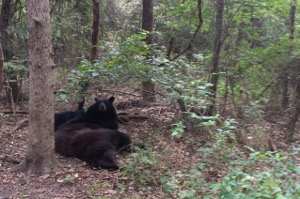 We leave the hilltop enclosures and wind down narrow rock roads through a scrubby, vine laden, forest toward Blue Creek, and through a gate that reads Dorfman Bear Orphanage.
We leave the hilltop enclosures and wind down narrow rock roads through a scrubby, vine laden, forest toward Blue Creek, and through a gate that reads Dorfman Bear Orphanage.
“We call it a bear orphanage because bears are a native species and most come here quite young. Their mothers get killed by cars, hunters and such,” says Dorfman.
Bears rescued from a roadside zoo frolic in their naturalistic bear habitat at IEAS.
But the latest round of IEAS bears is different and made headline news. When Michael “Sam” Simon, the co-developer of The Simpsons, realized the battle against his cancer was a losing one, he bestowed much of his fortune to PETA who used it to buy the freedom of wild animals kept in inhumane facilities.
At Chief Saunooke Bear Park in North Carolina, bears lived in below ground concrete pits with no shade from the southern heat, no protection from rain and bad weather, no warm den for sleep. Bears paced relentlessly, anxious and neurotic, begging from paying visitors who taunted and tossed occasional bits of purchased stale food. Ultimately the facility was 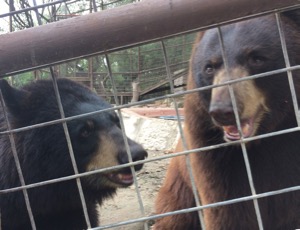 charged with 14 violations of the federal Animal Welfare Act.
charged with 14 violations of the federal Animal Welfare Act.
Two goofy, sweet black bears whose extreme tameness made them poor candidates for release in the larger enclosures.
PETA purchased the freedom of eleven black and brown bears from the owner of the bear pits and relayed them to IEAS. Most now amble through two naturalistic, high-fenced, five-acre habitats that can house up to nine bears. They splash in ponds, climb trees, tear through thickets and dig for grubs. They interact with other bears and nest together in comfy artificial dens. Each day, the bears receive a tray of produce and meats.
“It’s paradise for bears—with room service,” says Dorfman.
We stop for a moment and watch a couple of bears acting like bears. One lounges at the base of a tree, another grunts and snorfles like a big dog on a scent trail. Both move slowly; the cooler weather has triggered languid hibernation behavior. The half-chewed remnants of their meal lay nearby.
All three of us sit for a moment, thinking about all the bears endured and how they live now. For some of the bears, this was their first time to step onto the ground, to feel a plant, to be seen as more than a profit object. The first time to be valued solely for being bears. Dorfman mentions that Simon was able to see the bears here before he died. Not a dry eye in the golf cart.
International Exotic Animal Sanctuary
 About: IEAS’s current mission is the care and welfare of its animal inhabitants, as well as educating the public about their needs. The inhabitants include bobcats, cougars, jaguars, lions, tigers and bears, among other species. As of March 2013, 46 felines, 2 coatis and 16 bears call IEAS home, with spacious habitats, pools and houses.
About: IEAS’s current mission is the care and welfare of its animal inhabitants, as well as educating the public about their needs. The inhabitants include bobcats, cougars, jaguars, lions, tigers and bears, among other species. As of March 2013, 46 felines, 2 coatis and 16 bears call IEAS home, with spacious habitats, pools and houses.
IEAS staff member prepares trays of bear food.
Where: 3901 TX Hwy 114, Boyd, TX 76023
(940) 433-5091
Visit: Guided tours are at 11 am daily and also on 3 pm Saturdays. Private weekday tours are available for groups and schools.
Volunteer: Volunteers are sought on all levels at IEAS. Handy men and women are needed to maintain the extensive infrastructure of enclosures, roads and structures, plus the gardens and landscaped areas. Grocery stores in NW Tarrant donate past-date meat and produce. Preparing that food for animals requires a lot of daily effort. Interns studying animal husbandry and zoology in universities stay in a bunkhouse on site and lead most of the tours.
RELATED ARTICLES
North Texas Wild: WHO you gonna call? Blackland Prairie Raptor Center provides ER for birds of prey
North Texas Wild: Birds of all feathers ‘heal’ together at Rogers Wildlife Rehab Center
Feral pigs find home at Ellis County sanctuary
Black Beauty Ranch open house offers fun trek for animal lovers
Sign up for the weekly Green Source DFW Newsletter to stay up to date on everything green in North Texas, the latest news and events.Follow us on Facebook, Twitter and Pinterest.
Original post at: http://www.greensourcedfw.org/articles/north-texas-wild-local-behaviorist-says-captive-animals-need-emotional-enrichment





